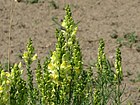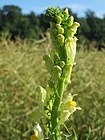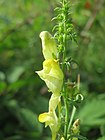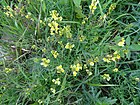Note: This is a project under development. The articles on this wiki are just being initiated and broadly incomplete. You can Help creating new pages.
Difference between revisions of "Linaria vulgaris - Yellow toadflax"
Chaithrika (talk | contribs) (+Common names) |
(→References) |
||
| (11 intermediate revisions by 2 users not shown) | |||
| Line 1: | Line 1: | ||
[[File:Linaria vulgaris - harilik käokannus Valingu.jpg|thumb|right|''Linaria vulgaris'']] | [[File:Linaria vulgaris - harilik käokannus Valingu.jpg|thumb|right|''Linaria vulgaris'']] | ||
| − | '''Linaria vulgaris''' | + | '''Linaria vulgaris''' is a species of toadflax family and it is native to most of Europe, northern Asia, the United Kingdom, Spain, east to eastern Siberia, and western China. |
| − | == | + | ==Uses== |
| + | {{Uses|Wounds}}, {{Uses|Cuts}}, {{Uses|Snakebites}}, {{Uses|Curing liver disorders}}, {{Uses|Skin eruptions}}, {{Uses|Blotches}}, {{Uses|Pimples}}, {{Uses|Diarrhea}}, {{Uses|Sore throats}} | ||
| + | |||
| + | ==Parts Used== | ||
| + | {{Parts Used|Dried folaige}}, {{Parts Used|Whole herb}}. | ||
| + | |||
| + | ==Chemical Composition== | ||
| + | The ability of Linaria vulgaris (Scrophulariaceae) infusion to act as a scavenger of 2,2-diphenyl-1-picrylhydrazyl (DPPH) radical, reactive oxygen species (superoxide radical, hydroxyl radical, hypochlorous acid (HOCl)) and nitric oxide was investigated.<ref name="chemical composition"/> | ||
| + | |||
| + | ==Common names== | ||
| + | {{Common names|kn=|ml=|sa=|ta=|te=|hi=|en=Yellow toadflax}} | ||
| + | |||
| + | ==Properties== | ||
| + | Reference: Dravya - Substance, Rasa - Taste, Guna - Qualities, Veerya - Potency, Vipaka - Post-digesion effect, Karma - Pharmacological activity, Prabhava - Therepeutics. | ||
| + | ===Dravya=== | ||
| + | |||
| + | ===Rasa=== | ||
| + | |||
| + | ===Guna=== | ||
| + | |||
| + | ===Veerya=== | ||
| + | |||
| + | ===Vipaka=== | ||
| + | |||
| + | ===Karma=== | ||
| + | |||
| + | ===Prabhava=== | ||
| + | |||
| + | ==Habit== | ||
| + | {{Habit|Herb}} | ||
| + | |||
| + | ==Identification== | ||
| + | ===Leaf=== | ||
| + | {{Leaf|Simple|Opposite|Stalkless. Blade linear, sharp-tipped, margins revolute.}}<ref name="Leaf"/> | ||
| + | |||
| + | ===Flower=== | ||
| + | {{Flower|Unisexual|25–30 mm|Orange|5-20|Flower is Irregular (zygomorphic). Corolla yellow, fused, bilabiate, spurred}} | ||
| + | |||
| + | ===Fruit=== | ||
| + | {{Fruit|Simple|7–10 mm|Clearly grooved lengthwise, Lowest hooked hairs aligned towards crown||Many}} | ||
| + | |||
| + | ===Other features=== | ||
| + | |||
| + | ==List of Ayurvedic medicine in which the herb is used== | ||
| + | |||
| + | ==Where to get the saplings== | ||
| + | ==Mode of Propagation== | ||
| + | {{Propagation|Seeds}}, {{Propagation|Cuttings}}. | ||
| + | |||
| + | ==How to plant/cultivate== | ||
| + | Succeeds in a moderately good well-drained soil<ref name="How to plant/cultivate"/> | ||
| + | |||
| + | ==Commonly seen growing in areas== | ||
| + | {{Commonly seen|Tall grasslands}}, {{Commonly seen|Meadows}}, {{Commonly seen|Borders of forests and fields}}. | ||
| + | |||
| + | ==Photo Gallery== | ||
| + | <gallery class="left" caption="" widths="140px" heights="140px"> | ||
| + | |||
| + | 20150629Linaria vulgaris2.jpg | ||
| − | + | 20150629Linaria vulgaris3.jpg | |
| − | + | ||
| + | 20160627Linaria vulgaris1.jpg | ||
| − | + | ||
| − | + | 20160627Linaria vulgaris2.jpg | |
| − | |||
| − | |||
| − | + | ||
| + | 20150722Linaria vulgaris.jpg | ||
| + | |||
| + | |||
| + | 20160717Linaria vulgaris.jpg | ||
| − | + | ||
| + | Linaria vulgaris Mill. (7616821878).jpg | ||
| − | + | </gallery> | |
| − | <references> | + | ==References== |
| − | <ref name=" | + | |
| − | + | <references> | |
| + | <ref name="chemical composition">[https://www.ncbi.nlm.nih.gov/pubmed/18569715 Antioxidative properties]</ref> | ||
| − | = | + | <ref name="Leaf">[http://www.luontoportti.com/suomi/en/kukkakasvit/yellow-toadflax Plant charecteristics]</ref> |
| − | + | <ref name="How to plant/cultivate">[https://www.pfaf.org/user/Plant.aspx?LatinName=Linaria+vulgaris Cultivation details]</ref> | |
| + | </references> | ||
| + | ==External Links== | ||
| + | * [https://www.tandfonline.com/doi/abs/10.1080/14786410601132360 Assessing the antioxidative properties and chemical composition] | ||
| + | * [https://www.cabi.org/isc/datasheet/30828 Linaria vulgaris on Invasive Species Compendium] | ||
| + | * [http://www.bioone.org/doi/abs/10.1614/IPSM-D-14-00082.1 Adaptive Development of Yellow Toadflax (Linaria vulgaris) Chemical Control Recommendations] | ||
[[Category:Herbs]] | [[Category:Herbs]] | ||
| + | [[Category:Ayurvedic herbs that don't have seed photos]] | ||
| + | [[Category:Plantaginaceae]] | ||
Latest revision as of 11:09, 4 June 2020
Linaria vulgaris is a species of toadflax family and it is native to most of Europe, northern Asia, the United Kingdom, Spain, east to eastern Siberia, and western China.
Uses
Wounds, Cuts, Snakebites, Curing liver disorders, Skin eruptions, Blotches, Pimples, Diarrhea, Sore throats
Parts Used
Chemical Composition
The ability of Linaria vulgaris (Scrophulariaceae) infusion to act as a scavenger of 2,2-diphenyl-1-picrylhydrazyl (DPPH) radical, reactive oxygen species (superoxide radical, hydroxyl radical, hypochlorous acid (HOCl)) and nitric oxide was investigated.[1]
Common names
| Language | Common name |
|---|---|
| Kannada | |
| Hindi | |
| Malayalam | |
| Tamil | |
| Telugu | |
| Marathi | NA |
| Gujarathi | NA |
| Punjabi | NA |
| Kashmiri | NA |
| Sanskrit | |
| English | Yellow toadflax |
Properties
Reference: Dravya - Substance, Rasa - Taste, Guna - Qualities, Veerya - Potency, Vipaka - Post-digesion effect, Karma - Pharmacological activity, Prabhava - Therepeutics.
Dravya
Rasa
Guna
Veerya
Vipaka
Karma
Prabhava
Habit
Identification
Leaf
| Kind | Shape | Feature |
|---|---|---|
| Simple | Opposite | Stalkless. Blade linear, sharp-tipped, margins revolute. |
Flower
| Type | Size | Color and composition | Stamen | More information |
|---|---|---|---|---|
| Unisexual | 25–30 mm | Orange | 5-20 | Flower is Irregular (zygomorphic). Corolla yellow, fused, bilabiate, spurred |
Fruit
| Type | Size | Mass | Appearance | Seeds | More information |
|---|---|---|---|---|---|
| Simple | 7–10 mm | Clearly grooved lengthwise, Lowest hooked hairs aligned towards crown | Many | {{{6}}} |
Other features
List of Ayurvedic medicine in which the herb is used
Where to get the saplings
Mode of Propagation
How to plant/cultivate
Succeeds in a moderately good well-drained soil[3]
Commonly seen growing in areas
Photo Gallery
References
External Links
- Ayurvedic Herbs known to be helpful to treat Wounds
- Ayurvedic Herbs known to be helpful to treat Cuts
- Ayurvedic Herbs known to be helpful to treat Snakebites
- Ayurvedic Herbs known to be helpful to treat Curing liver disorders
- Ayurvedic Herbs known to be helpful to treat Skin eruptions
- Ayurvedic Herbs known to be helpful to treat Blotches
- Ayurvedic Herbs known to be helpful to treat Pimples
- Ayurvedic Herbs known to be helpful to treat Diarrhea
- Ayurvedic Herbs known to be helpful to treat Sore throats
- Herbs with Dried folaige used in medicine
- Herbs with Whole herb used in medicine
- Herbs with common name in English
- Habit - Herb
- Index of Plants which can be propagated by Seeds
- Index of Plants which can be propagated by Cuttings
- Herbs that are commonly seen in the region of Tall grasslands
- Herbs that are commonly seen in the region of Meadows
- Herbs that are commonly seen in the region of Borders of forests and fields
- Herbs
- Ayurvedic herbs that don't have seed photos
- Plantaginaceae







